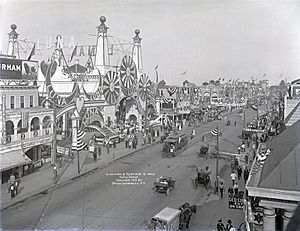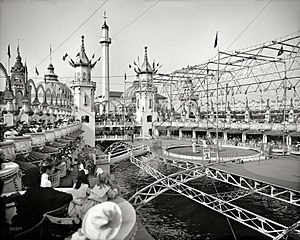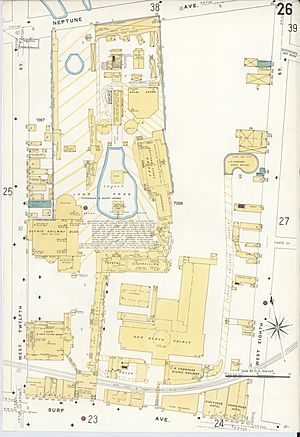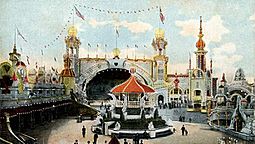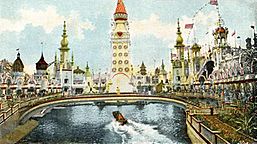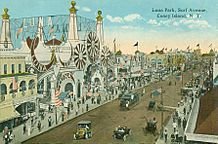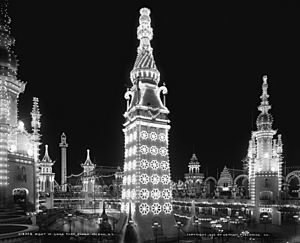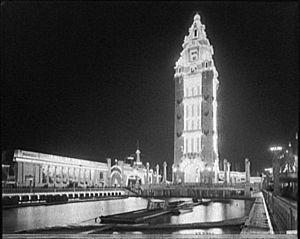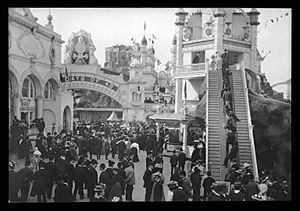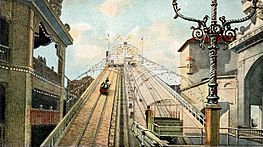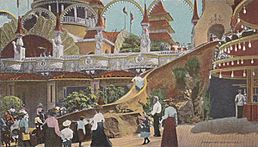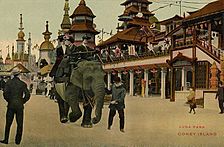Luna Park (Coney Island, 1903) facts for kids
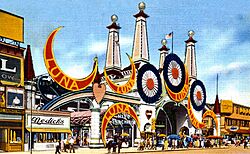
Luna Park entrance, early 20th century
|
|
| Location | Coney Island, Brooklyn, United States |
|---|---|
| Coordinates | 40°34′37″N 73°58′44″W / 40.577°N 73.979°W |
| Status | Closed |
| Opened | May 16, 1903 |
| Closed | August 13, 1944 |
| Owner | Frederic Thompson, Elmer "Skip" Dundy |
Luna Park was a famous amusement park in Coney Island, Brooklyn, New York City. It was located between Surf Avenue, West 8th Street, Neptune Avenue, and West 12th Street. Luna Park first opened its doors in 1903 and welcomed visitors until 1944.
This park was built partly on the land of an older park called Sea Lion Park. Sea Lion Park was special because it was the first enclosed and permanent amusement park in North America. Luna Park was the second of three big, well-known parks built on Coney Island. The others were Steeplechase Park (opened in 1897) and Dreamland (opened in 1904). Sadly, a large fire mostly destroyed Luna Park in 1944. It never reopened and was taken down two years later. Even though a new amusement park called Luna Park opened nearby in 2010, it's not connected to the original park from 1903.
Contents
History of Luna Park
How Luna Park Started
In 1901, two creative people, Frederic Thompson and Elmer "Skip" Dundy, made a very popular ride. It was called "A Trip To The Moon" and was part of a big fair in Buffalo, New York. The main part of the ride was a make-believe airship with flapping wings, named Luna. This name comes from the Latin word for the moon. The park itself might have been named after Dundy's sister, Luna Dundy Newman.
The owner of Steeplechase Park, George C. Tilyou, invited Thompson and Dundy to bring their show to Coney Island in 1902. But their agreement ended after one summer. Thompson and Dundy didn't like Tilyou's new offer, which would cut their earnings.
After the 1902 season, Thompson and Dundy decided to rent Paul Boyton's Sea Lion Park for a long time. Sea Lion Park was the first big enclosed park at Coney Island. It had opened seven years earlier. But after a bad summer and competition, Boyton wanted to leave the amusement park business. Thompson and Dundy rented Sea Lion Park, which was 16 acres. They also rented the land next to it, where the Elephantine Colossus Hotel used to be before it burned down. This gave them 22 acres of land to build a much bigger park.
Thompson and Dundy spent about $700,000 (they said it was $1 million!) to completely rebuild the park. They added many new attractions. Some rides from Sea Lion Park, like Shoot the Chutes, were kept.
The park looked like an amazing Eastern palace. It had grand buildings with over 1,000 red and white spires, towers, and domes. At night, more than 250,000 electric lights lit up all the domes and towers. In the middle of the park, there was a 200-foot-tall Electric Tower in the center of a lake. It had twenty thousand bright lights and waterfalls at its base. Later, two circus rings were hung over the central lagoon to entertain visitors between rides.
Luna Park called itself "The heart of Coney Island." It turned on its lights and opened its gates to 60,000 people at 8:05 PM on May 16, 1903. This was exactly when the sun set that Saturday night. It cost ten cents to get into the park, and rides cost extra, up to 25 cents for the biggest ones. People could easily get to the park by train.
How Luna Park Operated
Luna Park was very popular, but other parks on Coney Island also wanted visitors. The next year, a third big park called Dreamland opened. Dreamland had four times as many lights as Luna Park. It also had an even bigger central tower and attractions like "The End of the World." Dreamland was also known for its fancy buildings and more "high-class" shows. That park stayed open until 1911.
In the early 1900s, Coney Island was at its busiest. The three big amusement parks competed with each other. Many smaller attractions also tried to attract visitors.
In 1907, Dundy passed away. Frederic Thompson then ran Luna Park until 1912. He went bankrupt and lost ownership of the park to people he owed money to. However, he continued to manage it.
Luna Park continued to operate under different owners over the years. Rides were always being changed and updated. During the Great Depression (a time when many people lost their jobs and money), the park went bankrupt several times starting in 1933. Owners came and went, but none could make a good profit. Many shows and rides from the 1939 New York World's Fair moved to Luna Park after the fair closed. Luna Park was then called the New York World's Fair of 1941. When the US joined World War II, Luna Park was allowed to stay open to help people feel better. But its lights had to be dimmed for safety during wartime.
The End of Luna Park
A big fire on August 13, 1944, destroyed much of Luna Park. It caused $800,000 worth of damage. The park never reopened after this fire. There were legal problems over the park's insurance money. In August 1946, the park was sold to a company. They announced they would tear down what was left of Luna Park. They planned to build Quonset huts (simple, curved buildings) for military veterans and their families. That October, another fire destroyed the rest of the park.
Rides and Attractions at Luna Park
Besides "A Trip to the Moon," Luna Park had many other exciting rides and attractions over the years, including:
- "Shoot the Chutes" – a main water ride from the old Sea Lion Park.
- "Carousel" – a classic merry-go-round with music from a Wurlitzer Band Organ.
- "Bridge of Laughs" – a wobbly bridge designed to make you laugh.
- "Canals of Venice" – a relaxing gondola boat ride.
- "Dragon's Gorge" – a scenic indoor train ride (opened 1905).
- "The War of the Worlds" – a show based on the famous story.
- "The Kansas Cyclone" – a theater show about a tornado destroying a town.
- "Twenty Thousand Leagues Under the Sea" (1903–1904) – a show based on the famous book.
- "Midnight Express" – a miniature railroad ride.
- "Razzle Dazzle"
- "Helter Skelter" – a tall, twisting slide.
- "Hagenbeck's Wild Animals" – an animal show.
- "Little Egypt" – a show with exotic dancers.
- "The Teaser" – spinning wooden chairs.
- "The Tickler" (1907) – a large round tub that rolled down a winding path.
- "Trip to The North Pole" – a pretend submarine ride that ended in an Eskimo Village.
- "Old Mill" – a classic "tunnel of love" boat ride.
- "Witching Waves" (1907) – small cars that moved on a wavy floor.
- "Chinese Theater"
- "Professor Wormwood's Monkey Theater" – a show with trained dogs, monkeys, and apes.
- "Infant Incubators" – a display showing new ways to care for babies.
- "Trip to the Moon" – a roller coaster that moved to the Coney Island Bowery in 1924 and was renamed Drop the Dip.
The park also had a "Grand Ballroom," concerts, fireworks, and carnival shows. Thompson and Dundy often changed the park's attractions. For example, they replaced "20,000 Leagues Under the Sea" in 1905 with the indoor scenic railway called "Dragon's Gorge." Although the park's building included a sad event where Thompson and Dundy used electricity to put down Topsy the elephant for publicity, park owner Dundy grew to like the animals. Elephant rides became a popular feature of the park.
Luna Park's Legacy
In Popular Culture
Luna Park was so famous that it appeared in movies and songs:
- Roscoe Arbuckle's 1917 movie Coney Island shows Luna Park.
- The 1928 Oscar-nominated movie The Crowd by King Vidor has a scene filmed at Luna Park.
- Part of Harold Lloyd's 1928 movie Speedy was also filmed there.
- The song "Meet Me Down At Luna, Lena" was recorded by Billy Murray in 1905 to help promote the park. This song was re-recorded for a 2007 documentary film.
Parks Named After Luna Park
The land where the original Luna Park once stood now has a group of five apartment buildings called Luna Park Houses.
On May 29, 2010, a new amusement park also named Luna Park opened. This new park is on the site of the old Astroland park, which was across the street from where the original Luna Park used to be. The new park has modern rides, games, food, and live entertainment. Its entrance looks like the entrance to the original 1903 Luna Park.
See also
 In Spanish: Luna Park (parque de atracciones de 1903) para niños
In Spanish: Luna Park (parque de atracciones de 1903) para niños


